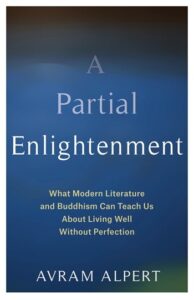
On the Role of Zen Buddhism in the Stories of J.D. Salinger
Avram Alpert Looks Closely at Franny and Zooey
In spite of all the famous cursing by Holden Caulfield, J.D. Salinger’s most famous character, the worst insult he gives in Catcher in the Rye (1951) is to call somebody a “phony.” The word appears about three dozen times in the narrative, and it covers just about everyone. Caulfield, in a climactic moment, even wonders if he himself might become a phony. He is thinking about lawyers. He considers that there might be some good to being a lawyer, but he doubts that even if he really were committed to saving the innocent, he could ever know if it was in fact for the moral good or because he wanted everyone to think so. “How would you know you weren’t being a phony? The trouble is, you wouldn’t.”
In this context, Caulfield imagines another scene of what he would really like to be, a scene in which nonphoniness (his authenticity) would be secured. It is a poignant vision from which the novel draws its title. He recalls (incorrectly, his interlocutor tells him) a line from a Robert Burns poem: “If a body catch a body coming through the rye.” (The correct line, it turns out, is “meet a body,” but Caulfield continues.) What he’d like to be is someone out on the edge of a field of rye where all these kids are playing. The field is perilously close to a cliff edge. There is no grown-up there besides himself, and his task is to catch the kids as they exit the field, before they fall over the edge. One after another, and forever, it seems.
In this dream, Holden seeks an authentic position in the world, and he recognizes it as an endless sacrificial job with no chance of recognition. There is no possibility of being a phony because there is no possibility of amour–propre, yet at the same time there is the necessary community—the children—to ensure the genuine purpose of the task. Ironically, the achievement of personal authenticity is based on an inauthentic rendering of the text (“catch a body” instead of “meet a body”). One could certainly argue that Caulfield’s problem is that he just wants to catch and release, rather than actually connect and meet. But one could equally claim that part of what makes his vision so authentic, so opposed to phoniness, is that it has such an original (inauthentic) relation to the original text.
The key connection for our purposes is between textual authenticity and personal authenticity. It is a theme that predominates in Salinger’s fiction, and, I will argue, is fundamental to his engagement with Zen Buddhism, especially as he learned it from the writings of D.T. Suzuki. (There are even rumors that Salinger attended Suzuki’s lectures in New York.) Although Salinger was unlikely to be aware of criticisms of Suzuki’s presentation of Zen as “Westernized” and “inauthentic,” he certainly had reasons to doubt that Zen itself was being authentically practiced in the United States. In Seymour—An Introduction, for example, the narrator, Buddy, remarks that “Zen is rapidly becoming a rather smutty, cultish word to the discriminating ear, and with great, if superficial justification. (I say superficial because pure Zen will surely survive its Western champions . . . Pure Zen . . . will be here even after the snobs like me have departed.)” “Western Zen” is not an authentic version of Zen, and thus the critique of it being promulgated in contemporary America is itself inauthentic; it critiques a bad copy as if it were the thing itself. The ironic layer here, again one that I doubt Salinger would have been aware of, is that what is called “pure Zen” is itself a modern construction by Suzuki and others.
This in turn raises another question, one generally overlooked by Salinger’s critics, although it seems to me to be at the heart of Salinger’s later fiction: Can one live an authentic Zen life in modern America? Is Zen a path to overcoming phonyism, or does it inevitably lead to the pious vacuity for which Buddy says it is rightly rebuked? Although recent critical appraisals of Salinger by critics like Amy Hungerford and Ross Posnock have helpfully turned attention to the religious themes in his work, both have also missed the central contestation about the plausibility of Zen that his characters enact. Hungerford, in attempting to articulate the nondoctrinal heart of “postmodern belief,” erases the specificity of Zen. Posnock, at the opposite extreme, finds everything that Salinger says to be entirely “Zen,” smoothing out the real dilemmas that Salinger’s fiction poses. Focusing on the same text they do—Franny and Zooey—I will suggest that the specificity of Zen matters very much to the characters, in large part because they find themselves incapable of living fully in accord with its demands. To be authentic, they will need not to become Zen but to achieve a spectral illumination about its meaning for their lives.
When we focus on Suzuki’s place in the novel, we discover that Salinger’s characters are struggling to discover whether or not the experience he offered is possible.
The narrative action of Franny and Zooey takes place as Franny has come home from university in the midst of a nervous breakdown, precipitated by her attempt to “learn the Jesus prayer.” The prayer is a technique passed down by her older brothers, Seymour and Buddy, through their copy of The Way of the Pilgrim. This religious text calls on its readers to learn how to pray without cessation through the act of repeating the prayer, “Lord Jesus Christ, have mercy on me” until “the prayer becomes self-active.” Franny tries to explain this to her boyfriend, who in turn attempts to psychologize her desire for “religious experience,” and then she passes out. She revives, but the damage seems to have been done, and when we find her next, it’s at her family home, lying on the couch, crying for hours on end.
As the story unfolds, we learn that The Way of the Pilgrim is one of several mystical religious texts that Franny and her brother Zooey were taught by Buddy and Seymour as part of their homeschooling. Buddy reveals his pedagogic intentions in a letter to Zooey some years after the fact: “[We began your education] not with a quest for knowledge at all but with a quest, as Zen would put it, for no-knowledge. Dr. Suzuki says somewhere that to be in a state of pure consciousness— satori—is to be with God before he said, Let there be light.” Buddy continues, with a hint of melancholy: “That, anyway, was the big idea.” The failure of the big idea is signaled first by the fact of Seymour’s suicide, and then by the ongoing struggles that both Franny and Zooey have with this education. The question now is whether or not the spiritual quest bequeathed to them can be realized in their bourgeois, materialist conditions.
The specificity of “Dr. Suzuki” is important for understanding this situation. In the mid-20th century, Zen exploded onto the international scene, especially in the United States. The man behind the boom was Suzuki (who did not in fact have a doctorate). He was a soft-spoken Japanese man who had lived, studied, and lectured extensively in Europe and America throughout his life. In the 1950s, he graced the pages of Time, Newsweek, and The New Yorker. When he lectured at Columbia in the same decade, people on the New York art and intellectual scene, including possibly Salinger, flocked uptown to follow his courses. His writings had a remarkable global and interdisciplinary reach. A still minimal list of those who cited him as an influence would include Jorge Luis Borges, Octavio Paz, Roland Barthes, Michel Foucault, Martin Heidegger, C. G. Jung, Agnes Martin, John Cage, Jack Kerouac, Yoko Ono, bell hooks, and Salinger.
The centerpiece of Suzuki’s Zen was his interpretation of satori, which he often translated as “awakening,” “enlightenment,” or “enlightenment-experience.” “To understand Zen,” he wrote, “it is essential to have an experience known as satori, for without this one can have no insight into the truth of Zen.” Satori for Suzuki is when we experience the universe exactly as it is—not without any thinking, but with a kind of thinking that is absolutely aligned with what is. Suzuki calls this being “transparent” to the universe. “For here is no negation, no affirmation, but a plain fact, a pure experience, the very foundation of our being and thought. All the quietness and emptiness one might desire in the midst of the most active mentation lies therein.” There is at once activity and quietness.
The relationship to authenticity is to be found here too. If part of what makes modern life feel so inauthentic is the falsity of advertising language, the flood of information that cannot be comprehended, and the self-conscious knowledge of one’s place in history, Zen promises to level all of these in a stroke—or better, in silence. It is not in grasping the world that one finds authentic being, and it is not in some mythic Romantic self. Rather, it is in undoing the very idea of self, in the recognition that the universe is nothing more—and nothing less—than a vital emptiness that grows into forms that inevitably transform and return to emptiness. It doesn’t matter if one catches another body or meets another body in the end; that’s just a linguistic problem, and authenticity is beyond language. Abandoning language and the idea that truth was ever available in it, we find that we are all equally nothing and everything.
But Suzuki also offered authenticity in concrete ways: he embodied it in his simple demeanor and carefully crafted image, and he culturalized it, suggesting that Japan as a nation showed the possibility of being Zen (even if that cultural essence had gone horribly awry in the war). To a generation adrift in postwar trauma, affluence, and contradiction, Suzuki showed that it was possible to be otherwise. And, by appearing as an “other” himself who was nevertheless perfectly comfortable in American culture, Suzuki suggested that one could achieve enlightenment and still act with “suave efficacy” in the world. John Cage and Alan Watts (like Charles Johnson) cite Suzuki as saying that life after satori is like everyday experience, but a few feet off the ground. You are in this world, but at the same time, you experience it in a new way, full of quiet, calm, wonder, and perspicacity.
One might wonder whether such a marvelous experience is possible, or even desirable. The debate continues, but three decades of scholarship in Europe, Japan, and the United States have responded to this question with a resounding no. Hakugen Ichikawa, for example, contended that satori should signify not only this moment of calm but also a simultaneous experience of understanding the social world. Hakamaya Noriaki has argued that satori is in fact a meaningless aim, since it is only being awakened as from sleep, not gaining enlightened insight into the true structure of reality. Robert Sharf and others have even suggested that satori—as a mental state that is beyond discrimination and judgment—can be used to create pliant subjects, and thus was part of the ideological framework of Japanese fascism. And even those within Buddhist studies who defend Suzuki, such as Victor Hori, believe that the idea of “pure consciousness” goes too far and disables Zen acolytes from understanding how it is that Zen relates to everyday, impure experience. “There is no Zen enlightenment beyond thought and language in a realm of pure consciousness,” Hori states unequivocally. I have argued elsewhere that this scholarship misses some of what is important in Suzuki’s thought, but the point here is simply that Suzuki’s ideas are contested in Buddhist studies scholarship, while left largely unquestioned in literary studies. This is especially important because they are contested in the fictional accounts themselves.
The debate over the plausibility of enacting Suzuki’s ideas is central to Salinger’s Franny and Zooey. Posnock notes that the story “insists on the distance between the spiritual ideals the main characters articulate and the pettiness of their behavior,” but he goes on to conclude that the distance can be overcome “via the radical critique of instrumentality or attachment found in Eastern and Christian mysticism.” In other words, by overcoming our desire to grasp and manipulate the world, we can be freed from the mental habits that block our path to enlightenment.
Posnock’s book is an intriguing model of a wandering literary criticism that takes renunciation and its potential for creativity very seriously. But it runs a genuine risk in statements like this, which tend to level all modes of renunciation into general themes. He is thus mostly unconcerned with whether he is quoting Suzuki or the Tao te Ching, or a generalization on both in the late work of Roland Barthes. This allows Posnock some rather lovely riffs on Zen, such as the possibility of being “in tune with the Zen edict that abolishes closure and hierarchy for receptivity to the ubiquity of the divine in the things of this world” (a rather idiosyncratic but not implausible modern Zen gloss on the idea of buddha nature). But by ignoring the actuality of Buddhism, Posnock eventually turns away from the rather bedeviling question he points to in Franny and Zooey:
What are we to make of that troubling gap between the textual inscription of such a possible life and the embodied possibility of actually living it? This is the problem at the heart of Sharf’s critique of modern Buddhism: “scholars read ideological prescription as phenomenological description.” In other words, they think that because there is an ideal in Zen, it necessarily follows that that ideal is perfectly embedded in the culture. But this is rarely, if ever the case. And that matters here because it is also what is at stake in the novel.
This problem is similarly glossed over in Hungerford’s reading. For her, Franny and Zooey is a perfect embodiment of mid-century American religion, which strove to unite religious belief with pluralism. How does one hold on to faith without assuming that one’s faith is more correct than everyone else’s? Hungerford suggests that this requires a balance between specificity and transcendent truth that the characters propagate through the idea of acting: Zooey “solves the tension between syncretism and specificity, between wisdom and no-knowledge, by transforming a theory of religion into a theory of acting.” This is because in acting one may embody specific role after specific role, but then always return to a kind of primordial silence from which the acting draws its power.
Curiously, Hungerford only concerns herself with the specificity of Christianity as enactment in her brief reading of the novel, in spite of the fact that the idea of the primordial silence, of “no-knowledge,” comes from Suzuki. When citing the passage about Buddy and Seymour’s teaching of satori, she literally erases Suzuki’s name by ellipses.46 And when she gives a list of religious figures who have inspired the brothers, she doesn’t pause to note the one exception, “Mu-Mon-Kwan,” which is not a person but a collection of kōan. These details suggest that Zen, and especially Suzuki’s presentation of it, is being singled out, and perhaps precisely for the reasons Buddy gives in Seymour: because its promised ability to deliver authenticity just does not seem to be working in modern America.
Suzuki’s Zen promised something very specific: that there was an experience of purity available in this world that could change the entire nature of everyday life, making us the authentic creatures we all seek to be. This was not Zen wisdom from time everlasting. This was a spiritual doctrine carefully updated for the modern world. When we focus on Suzuki’s place in the novel, we discover that Salinger’s characters are struggling to discover whether or not the experience he offered is possible. And what the narrative ultimately suggests is much closer to Suzuki’s critics. Franny and Zooey find that Suzuki’s Zen fails to offer them a new mode of being in the world. Instead, it leaves them stuck between the imagined ideal of their brothers and the sordid realities of commercialist America.
Franny and Zooey’s education not only put them at odds with the vanities of the world but also failed to actually help them transcend that world.
We can see this beginning in Zooey’s discussion of his sister’s situation with their mother. He pins the blame squarely on the older brothers’ failed education: “We’re freaks, the two of us, Franny and I . . . I swear to you, I could murder them both [Buddy and Seymour] . . . The great teachers. The great emancipators. My God. I can’t even sit down to lunch with a man any more and hold up my end of a decent conversation.”48 Zooey is too obsessed with the spiritual ideals of his brothers to be able to function in the daily world. His brothers never actually gave him spiritual emancipation, and unfortunately the “social liberation” they offered was only from the ability to be a good friend! He repeats the same lament to Franny herself later: “We’re freaks . . . with freakish standards. We’re the Tattooed Lady, and we’re never going to have a minute’s peace, the rest of our lives, until everybody else is tattooed, too.”49 They were brought up with a spiritual value system that is completely unrecognizable to the rest of the world, so they constantly crash up against the values of that world. They are always seeking the before-the-world, the authentic moment of satori that is the unconditioned beginning of the universe, and instead finding themselves in the materialist conditions of this world.
Material things are everywhere in the story. The clash between things and the conditions that enable enlightenment (becoming unconditioned, in classical descriptions of nirvana) comes across particularly nicely in a classic pun from German Romanticism. In a fragment from Miscellaneous Remarks, Novalis wrote, “We seek everywhere the unconditioned (das Unbedingte), and we find only things (Dinge).” Franny and Zooey at times reads like an updated version of this claim within the conditions of modern-day American materialism. Indeed, as the characters seek enlightenment, they keep finding only things. Their apartment may not be “impressively large,” but it does have “accumulated furnishings [that] might have lent a snug appearance to a banquet hall in Valhalla.” A description of just one bathroom’s medicine cabinet lists forty items (not including duplicates), and “inconceivably or no, quite a good deal more.”
Franny and Zooey are spiritual freaks in this materialist world, and they can never quite fully separate the two. Thus Franny states: “Just because I’m choosy about what I want—in this case, enlightenment, or peace, instead of money or prestige or fame or any of those things—doesn’t mean I’m not as egotistical and self-seeking as everybody else.” She seeks the unconditioned but suddenly finds that it too is a thing, a social commodity. Of course, Buddhism always had a relation to economy. But a general relation to economy is not as undermining as the specific modern power of money, which, as Lionel Trilling notes in his book on authenticity, is “in short . . . the principle of the inauthentic in human existence” since it has the power to transform anything into its opposite simply by paying for it.
Franny and Zooey’s education not only put them at odds with the vanities of the world but also failed to actually help them transcend that world. This is, again, the double pain invoked when Zooey calls Buddy and Seymour “the great emancipators”: they did not emancipate their siblings from the world or from its vanities. Modernized Buddhist wisdom simply cannot perform its task of rendering Franny and Zooey authentic because they do not find the right conditions for its enactment. Whether or not they have really lost the object—the other world—they eventually decide that they must learn to act as if they have. This is their final lesson to each other.
__________________________________
 Excerpted from A Partial Enlightenment: What Modern Literature and Buddhism Can Teach Us About Living Well Without Perfection by Avram Alpert. Copyright (c) 2021 Columbia University Press. Used by arrangement with the Publisher. All rights reserved.
Excerpted from A Partial Enlightenment: What Modern Literature and Buddhism Can Teach Us About Living Well Without Perfection by Avram Alpert. Copyright (c) 2021 Columbia University Press. Used by arrangement with the Publisher. All rights reserved.
Avram Alpert
Avram Alpert teaches writing at Princeton University. He is the author of Global Origins of the Modern Self, from Montaigne to Suzuki (2019). He is also coeditor of Shifter magazine and has written cultural criticism for outlets including the New York Times, the Washington Post, the Brooklyn Rail, and Truthout.












